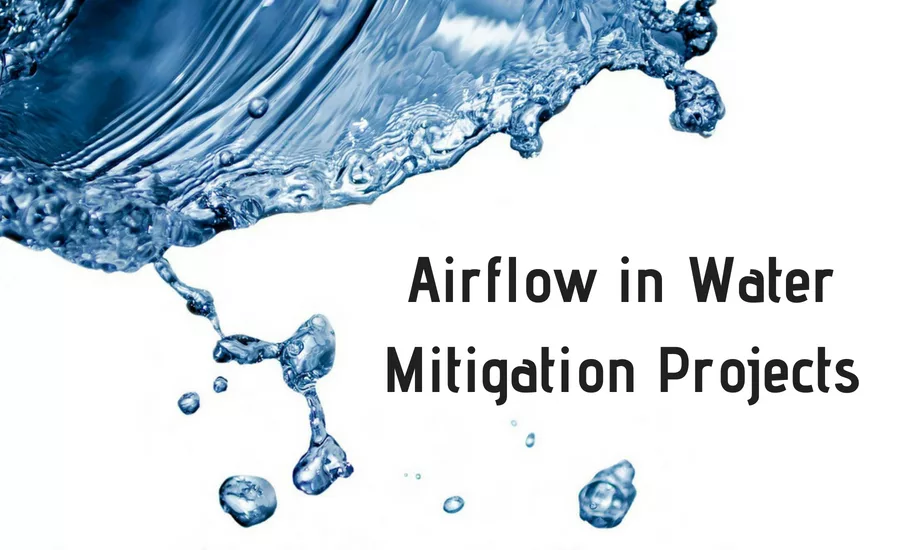Airflow in Water Mitigation Projects

Of the processes used in water damage restoration to remove excess moisture, none is more important than air flow. In this article, we will discuss this principle of drying from three vantage points: (1) The documented science, (2) Industry standards, and (3) implementing best practices in your restoration business.
Documented Studies and Science
Air movement is only a part of the recipe for driving evaporation in a drying system. It must be accompanied by appropriate control of energy (heat) and humidity. Numerous studies and formulary expressions exist that show however that air flow is in basic terms a multiplier, where higher air speed moving across an evaporating surface has a direct and proportional effect on evaporation rate.
There are two very common misconceptions with air flow in the restoration community. First, the benefit of air flow is temporary. Once building materials have released liquid water at or near the surface, lower air speeds will deliver the same benefit. Second, the flow of air MUST be in direct contact with the evaporating surface.
To fully leverage air flow while maximizing efficiency, your restoration business must have the skills necessary to evaluate air mover installations both initially and throughout the drying process. Adjustment to placement and quantity based on measurement and evaluation of critical psychrometric readings will yield faster drying, stronger estimate justification and strong project cost management.
Industry Standards and Practices
Although several guidance documents, manuals, and publications are available within the water mitigation industry, the most referenced document is the ANSI/IICRC S500 Standard and Reference Guide for Professional Water Damage Restoration (S500).
The S500 requires a continuous flow of air across wet surfaces. It also states that in specific circumstances, it can be beneficial to decrease airflow velocity as surface water has been evaporated (and remaining water is absorbed or bound within materials). This direction given by the S500 is in perfect agreement with the information available within the scientific community.
The S500 standard presents a method for calculating the initial amount of airflow needed on a specific water mitigation project. The method however does not address the effect of airflow speed. It assumes a commonality for commercially available air moving devices and calculates a quantity of these devices necessary.
The calculation uses the following steps and parameters:
- Install one air mover in each affected room or space
- Add an additional air mover for every 50-70 square feet (SF) of affected wet flooring
- Add an additional air mover for every 100-150 SF of affected wet ceilings and wall areas above approximately 2 feet
- Add an additional air mover for each wall inset and offset greater than 18 inches
The standard also references that in rooms smaller than 25 square feet, a single air mover may be adequate. Further, the standard addresses the unique circumstance where the primary wet surface area is along the lower portion of walls, with little flooring affected. In these cases, the standard suggests using the alternative method of installing an air mover for every 14 linear feet of affected wall.
The S500 standard addresses the need to adjust and change the application of airflow through two processes. First, in Class 4 intrusions (deeply held or bound water), the document requires a decrease in vapor pressure once surface water has been evaporated. The document further references that it can be beneficial to decrease airflow velocity. The second process is an overall adjustment to airflow as building materials dry. The standard requires restorers to inspect and make appropriate adjustments to the number, type and placement of air movers based on materials’ moisture readings.
This direction can achieve a positive result but is not in complete agreement with the principles common in the scientific information explored earlier in this paper. Two significant additions to this language are necessary to fully leverage airflow while maximizing efficiency of airflow resources.
First, the information that must be monitored to understand the validity of airflow adjustment is the vapor pressure of the air in contact with the evaporating surface. The maximum benefit from airflow is being achieved when the vapor pressure at the evaporating surface is equal to that of the air supply used by air moving devices (e.g., the air in the balance of the room or space).
Second, the drying chamber must be evaluated to ensure air moving device placement is properly circulating and distributing an adequately warm and dry air mass to each affected space. This is a very different assessment than the vapor pressure at the surface of the evaporating material. It is a measurement of the temperature and moisture content of the air in various locations throughout the drying chamber.
Air Mover Monitoring and Adjustment
Psychrometry is a vital tool for understanding the efficacy of your air mover deployment. Immediately following installation, air throughout the drying chamber should be monitored to ensure the air mover installation scheme is effective. There are two types of measurement necessary to make this determination:
- Take at least two measurements of temperature and relative humidity, each from opposing ends of the drying chamber.If the two conditions are in close agreement, the circulation has been properly established.When the conditions are significantly different, refer to steps one and two under Air Mover Installation earlier in this document.Ensure the steps prescribed have been followed with no exception.
- Only after circulation has been verified, measure the air immediately in contact with several wet surfaces by placing a hygrometer within ½” of the wet material.If the condition here is in close agreement with the temperature and humidity measured in step 1, airflow is adequate across the surface.If there is a significant difference, additional air speed is required.
- This step is especially critical in larger rooms near the center of the room. Use this measurement to determine if axial type air movers are needed to add flow in the center of large spaces. It is also very helpful in determining if enough flow is present in hard to reach spaces created by complex assemblies.
Integrating Best Practices
As with any procedural change or emphasis, implementing the practices outlined in this document will require organizational commitment. Various levels of the organization will need to participate to ensure the adoption of the process is successful.
Company financial commitment must be made in the form of quality hygrometer instruments for field technician use. Time resources must also be committed to allow for training. Technicians must understand the methods outlined in this document, how to properly use hygrometers, and the importance of following the training as a matter of routine. Estimators and project managers need to understand the method to ensure proper documentation and notes are captured to justify specific equipment use.
All information used to make decisions related to how a project is managed should be documented. If it serves as the basis for a technician’s decision, it will also serve as justification for the project costs. The importance of documentation is stressed in implementation because if a procedure is met with opposition, the documentation that demonstrates the value and purpose must be used for clarification.
The most critical element of implementation, however, is making sure that training and communicating the procedure’s priority is the standard in your organization. In conjunction with this white paper, several resources can assist with ongoing training and sustaining success. If you need assistance accessing these resources, please contact the publisher of this white paper.
Author & Acknowledgements
This article was written by the team at Next Gear Solutions, LLC of Oxford MS. Next Gear Solutions. Content was derived based on the white paper titled Managing Air Flow in Water Mitigation, published in June of 2018, by Brandon Burton. For the full white paper, please click here.
Institute of Inspection, Cleaning and Restoration Certification, M Lee, C Taylor et al, ANSI/IICRC S500:2015, 2015
Looking for a reprint of this article?
From high-res PDFs to custom plaques, order your copy today!







